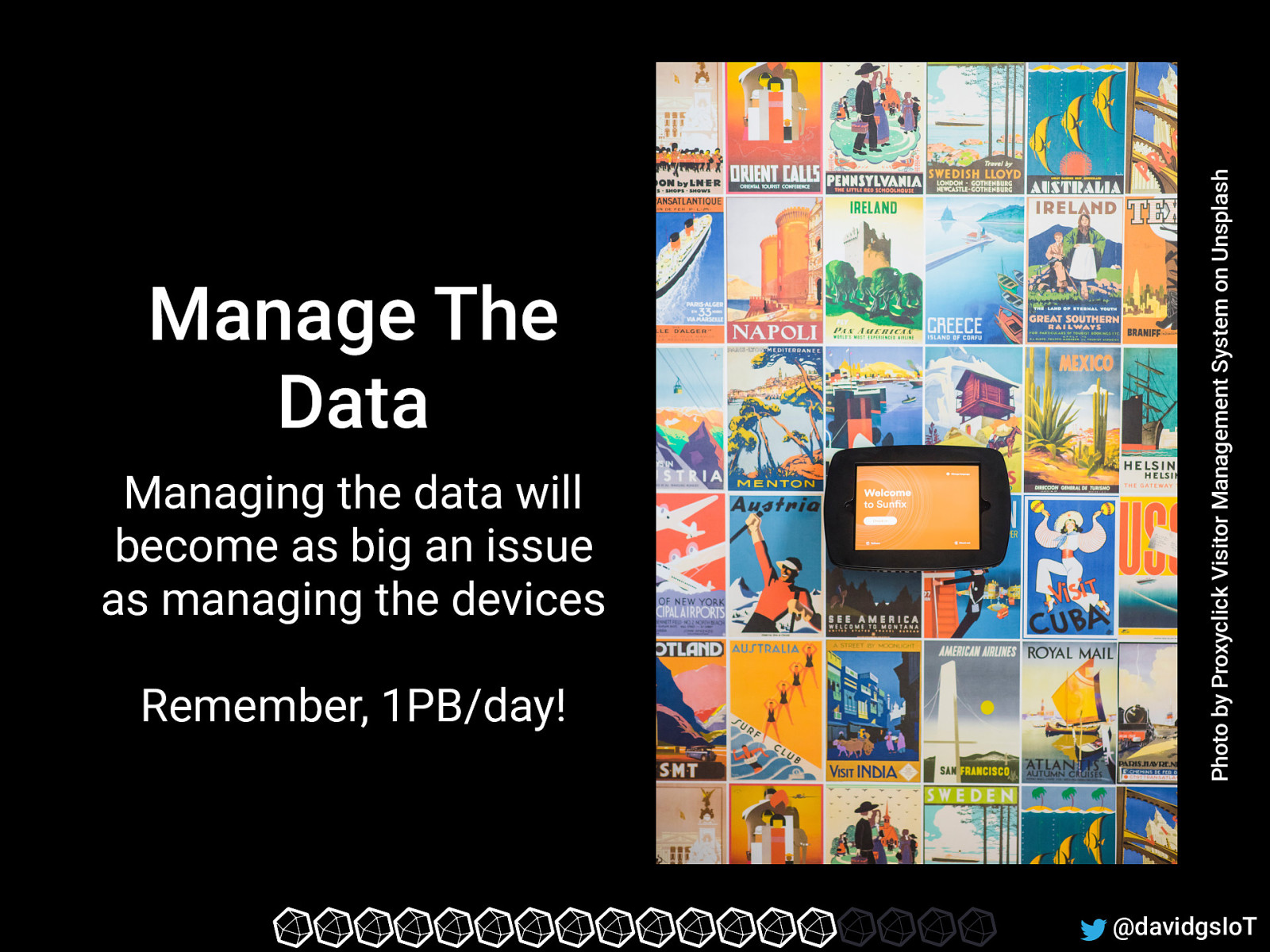a t a D The Internet of Things David G. Simmons Senior Developer Advocate, InfluxData @davidgsIoT
Slide 1

Slide 2

This Talk Will Be Heresy ps: it’s not about things at all @davidgsIoT
Slide 3

How it started* Project SunSPOT[1] Sun Labs Started in 2003 First 32-bit IoT Developer Platform 802.15.4 Radios IPv6 Nothing to store the data * for me @davidgsIoT A brief history of the IoT from a developer/hacker’s perspective … Makers really started this whole thing. Developers like you and me who began tinkering with micro controllers and sensors WE built this industry. How many people remember the Sun SPOT? Anyone used one? Anyone still have one?
Slide 4

Next Came Arduino 8-bit MCUs No Networking Released in 2007 Not 32-bit until 2012 @davidgsIoT This really opened up the mass-market to IoT and IoT development We made robots, we controlled light switches, we started connecting all the things!
Slide 5

A Protocol History? 802.11: 802.15.4: Zigbee: BLE: LoRaWAN: 1997 2003 2003 2004 2015 @davidgsIoT 802.11 is, of course, WiFi and has been around the longest, but it’s a relatively power-hungry approach, with limited range 802.15.4 is much lover power, but also much shorter range, and a lot more limited bandwidth Zigbee is just 802.15.4 with stuff. BLE is low power, but even shorter range LoRaWAN looks to be the best for IoT as it is low power and long range (though limited bandwidth)
Slide 6

✦ The Internet of Things ✦ All about the ‘Things’ ✦ Data was secondary Photo by Alina Grubnyak on Unsplash In the Beginning @davidgsIoT Everyone talked about the things — heck this is The THINGS Network Conference! It was all about the things that we were connecting to the Internet. All the things we would instrument Jets, cars, greenhouses, farms, medical devices, all the things!
Slide 7

Collect data React to data Model systems Make Digital Twins Photo by Mohaiminul Islam Meshal on Unsplash Why are we doing this? @davidgsIoT But why are we connecting all these things to the internet? Collect data — telemetry — about the things we are measuring React to the data — make real-time decision about processes based on incoming data Model our systems so that we can better understand them and react to them MAKE DIGITAL TWINS!!
Slide 8

✦ 20 Billion things? ✦ 100 Billion things? Photo by Yun Xu on Unsplash Billions of Things ✦ Depends on whom you ask, and when ✦ Still all about the things @davidgsIoT But what about all those things? How many would there be? 20 Billion? 100 Billion? Every Analyst has a different number of things, depending on when and whom you ask Still all about the things themselves This is great if you make things, sensors, MCUs, whatever it is.
Slide 9

All The Things [2] @davidgsIoT
Slide 10

@davidgsIoT But it’s not really about all the things. It’s not really about all the sensors because what are those sensors doing? Collecting data!!
Slide 11

But the Data! Let’s Do Some Maths 75 billion things 10 bytes of data per thing Every minute, of every hour of every day 750,000,000,000 bytes/minute 750 GB/minute 1 PB/day @davidgsIoT A PetaByte per DAY. And here’s the thing about the Internet of things. We deploy these sensors and begin sending data and, for the most part, we NEVER turn them off. So this is a PetByte a day, FOREVER. 400 PB/year, roughly speaking. What do you do with all that data?
Slide 12

It’s no longer about the Things Collect Analyze Interpret Visualize React Store Expire Remove @davidgsIoT
Slide 13

Heresy!!!! I told you so @davidgsIoT
Slide 14

Managing the data will become as big an issue as managing the devices Remember, 1PB/day! Photo by Proxyclick Visitor Management System on Unsplash Manage The Data @davidgsIoT How do we store that much data affordably? How do we sort, analyze and react to that much data? How do we reasonably visualize and understand that much data? How do we decide what data matters, and what doesn’t, and how long to keep the data around?
Slide 15

Start with the answers you’re looking for Move to the data you’ll need to get those answers Finish with the devices you need to get that data Photo by Markus Spiske on Unsplash Data First Things Second @davidgsIoT As much as an IoT project needs a hardware and software deployment and maintenance architecture, it needs a complete data management architecture. I suggest STARTING with the data architecture Decide what decisions you will make based on your data collection Decide how you will make those decisions Figure out what data is absolutely required to collect, and what you can derive/infer from other data Decide how long you need to keep each bit of collected data
Slide 16

Remember … ✦ It’s about the data, not the Things ✦ It’s about what you do with the data, not just about collecting it ✦ Data must be actionable to be useful ✦ It’s about managing the data after you collect it @davidgsIoT
Slide 17

It’s the Internet of Data @davidgsIoT
Slide 18

Thank You! @davidgsIoT
Slide 19

Sources 1:http://sunspotdev.org 2. https://www.researchgate.net/figure/Internet-of-Things-IoT-connected-devices-from-2015to-2025-in-billions_fig1_325645304 : @davidgsIoT